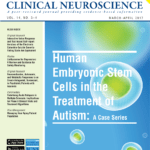 Dear Colleagues:
Dear Colleagues:
Welcome to the March–April 2017 issue of Innovations in Clinical Neuroscience. We start this issue with an interesting case series by Shroff titled, “Human Embryonic Stem Cells in the Treatment of Autism: A Case Series.” Here, investigators administered human embryonic stem cell therapy to three children with autism spectrum disorder (ASD) in an effort to improve blood perfusion in their brains, which theorectically improve motor, social, and cognition skills. After 3 to 4 treatment phases (each 4 to 6 weeks long) that were separated by 4- to 8-month gap phases, the authors report that the patients showed improvement in eye coordination, writing and balancing abilities, and cognitive skills; were no longer hypersensitive to sounds or smells; and spoke more clearly/loudly. The authors discuss their results and briefly describe potential mechanisms by which stem cells may improve brain blood perfusion in this patient population. Studies with larger sample sizes are needed to support the use of human embryonic stem cell therapy in this patient population.
Following this, in their study titled, “Interactive Voice Response and Text-based Self-report Versions of the Electronic Columbia-Suicide Severity Rating Scale Are Equivalent,” Gwaltney et al sought to compare the equivalence of a new version of the electronic Columbia-Suicide Severity Rating Scale (eC-SSRS) that was administered on a tablet device with the existing interactive voice response (IVR) version in order to support the prospective monitoring of suicidal ideation and behavior in clinical trials and practice. Participants comprised 58 recently admitted psychiatric inpatients and 28 employees of the hospital site. Participants completed both tablet and IVR versions in randomized order, with a 25-minute break between administrations. Then participants completed a second administration of the first administered version. The authors report that scores from both modes significantly differentiated psychiatric patients and hospital employee controls, and that the test-retest reliability of both modes was excellent. The authors concluded that the new tablet-based eC-SSRS is valid and reliable and may be useful in a wider range of studies and in clinical practice.
Next, Touma et al provide a review of liothyronine in their article, “Liothyronine for Depression: A Review and Guidance for Safety Monitoring.” Here investigators discuss triiodothyronine’s (T3, liothyronine) mechanism of action, efficacy in enhancement and augmentation trials, and dosing and safety considerations for the treatment of depression. The authors report that most studies show liothyronine to be an efficacious enhancement and augmentation strategy for depression in combination with antidepressants, primarily tricyclic antidepressants and selective serotonin reuptake inhibitors.
Following this, in their article, “Neuroendocrine, Autonomic, and Metabolic Responses to an Orexin Antagonist, Suvorexant, in Psychiatric Patients with Insomnia,” Nakamura and Nagamine performed a prospective study on 40 psychiatric inpatients treated with suvorexant from December 2014 to April 2016. Questionnaire of Pittsburgh Sleep Quality Index (PSQI), Generalized Anxiety Disorder-7 (GAD-7), and Patient Health Questionnaire-9 (PHQ-9) scores were checked at baseline, Week 2, and Week 4, and fasting serum levels of prolactin, insulin, cortisol, noradrenaline, white blood cell count, and average pulse rate were measured at baseline, Week 4, and Week 8 after suvorexant initiation. Sequential change of the values were compared against baseline, respectively. The investigators report that the participants’ subjective sleep quality scores were significantly decreased at Weeks 2 and 4, and sleep duration, habitual sleep efficacy, and global scores were significantly decreased at Week 4 from baseline. GAD-7 and PHQ-9 scores and levels of pulse rate were also significantly decreased at Week 4 from baseline, while levels of cortisol and white blood cell count significantly decreased at Week 8. The authors report that suvorexant treatment resulted in overall improvement in the quality of sleep and the severity of anxiety and depression, and discuss how dual orexin antagonist may be related to autonomic functions and neuroendocrine systems, especially in the hypothalamus-pituitary-adrenal axis in psychiatric subjects.
Next, in a commentary titled, “Redefining Acute Relapses in Multiple Sclerosis: Implications for Phase 3 Clinical Trials and Treatment Algorithms,” Avasarala reviews the current standard of determining acute relapse in multiple sclerosis (MS) in both clinical practice and clinical research, and discusses this standard’s limitations. The author then proposes a more modern definition of acute relapse in MS and includes a supportive discussion on the current and emerging roles magnetic resonance imaging and “big data” are playing in the prevention, diagnosis, and treatment of MS.
And finally, in this issue’s installment of Risk Management titled “Managing Your Aging Patient Population,” McNary reviews potential professional liability risks related to treating elderly patients and provides suggestions on how to best serve this patient population while avoiding liability pitfalls.
We hope you enjoy the issue. As always, we welcome your feedback and submissions.
Sincerely,
Amir Kalali, MD
Editor, Innovations in Clinical Neuroscience





